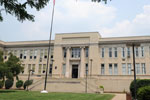
Former Turtle Creek High School’s Architecture, Importance Honored
By Tom Fontaine
PITTSBURGH TRIBUNE-REVIEW
Thursday, July 15, 2010

On Saturday, officials will unveil two historical markers that commemorate the former Turtle Creek High School building's architectural significance and role in the community. Officials debated about demolishing the building five years ago, but a group led by former graduates Jill Hinkle, Bob Mock, Jeanne Flaherty and Connie Morenzi led vocal opposition. The Classical Revival-style, cream-colored brick building with stone and terra cotta trim was designed by Pittsburgh architect George Henry Schwan. Jasmine Goldband | Tribune-Review
The former Turtle Creek High School building has gone by several names and narrowly avoided the wrecking ball to remain a community centerpiece since opening during World War I.
On Saturday, officials will unveil two historical markers that commemorate the Monroeville Avenue building’s architectural significance and role in the community.
Although the markers were installed last week, the building was placed on the National Register of Historic Places three years ago and received historic designation last fall from the Pittsburgh History and Landmarks Foundation.
“It basically validates what people in Turtle Creek have felt all along,” said councilwoman Jill Henkel of the markers. Henkel is a 1978 graduate of the former Turtle Creek High School and one of four Turtle Creek natives who led a push to obtain historical designation for the building.
Ground was broken on the $200,000 building in August 1917, and it opened in February 1919 as Union High School, with students from Turtle Creek, Wilmerding, East Pittsburgh and parts of nine other communities, according to documents related to the National Register of Historic Places designation.
The Classical Revival-style, cream-colored brick building with stone and terra cotta trim was designed by Pittsburgh architect George Henry Schwan. He also designed the Twentieth Century Club’s original building in Oakland, the former Oakmont High School and laid out plans for factory-worker developments in Aliquippa and Akron, Ohio.
The building wasn’t home to just high school classes.
Westinghouse employees trained at night in classrooms and vocational shops. Women used school sewing machines after hours to earn money during the Great Depression. And the school’s large lawn provided “the only open green space in the borough,” Henkel said.
“Even today, people are always playing in it,” Henkel said of the lawn. “It’s basically a community park.”
The school would hit a peak enrollment of more than 2,100 students in the 1930s. Also in that decade, after East Pittsburgh and Wilmerding opened their own high schools, Union’s name was changed to Turtle Creek High School. In 1940, the school graduated just 365 students.
When Turtle Creek became part of the newly created Woodland Hills School District in the 1980s, the building became the new district’s East Junior High. Officials debated about demolishing the building five years ago, but a group led by former graduates Hinkle, Bob Mock, Jeanne Flaherty and Connie Morenzi led vocal opposition.
Ultimately, the district moved East Junior High students elsewhere and mothballed the Turtle Creek building for the 2008-09 school year; it reopened last August, housing the district’s new Woodland Hills Academy for elementary students.
“I would have laid down in front of the bulldozer if they tried to tear down the building,” said Mock, a 1968 graduate.
The unveiling of the marker, part of Turtle Creek Community Days festivities, begins at 7:30 p.m. on Saturday at 126 Monroeville Ave.
